Applied Corporate Strategy: A Strategic Analysis of Uber
VerifiedAdded on 2023/06/18
|13
|3766
|448
Report
AI Summary
This report presents a strategic analysis of Uber Technologies, a global technology organization providing ride-hailing, food delivery, and freight transportation services. The analysis includes an external assessment using the PESTLE framework, examining political, economic, social, technological, legal, and environmental factors impacting the taxi industry. Porter's Five Forces model is applied to evaluate industry structure, including buyer and supplier power, the threat of new entrants and substitutes, and competitive rivalry. The report also conducts an internal analysis, identifying Uber's key resources (financial, human, physical, and intangible) and applying the VRIO framework to assess their value, rarity, imitability, and organizational alignment. Furthermore, a value chain analysis examines Uber's primary (inbound logistics, operations, outbound logistics, marketing and sales, services) and secondary activities (procurement, technology development, human resource management, and firm infrastructure) to determine sources of competitive advantage. Finally, the report evaluates the suitability, accessibility, and feasibility of Uber's strategies.
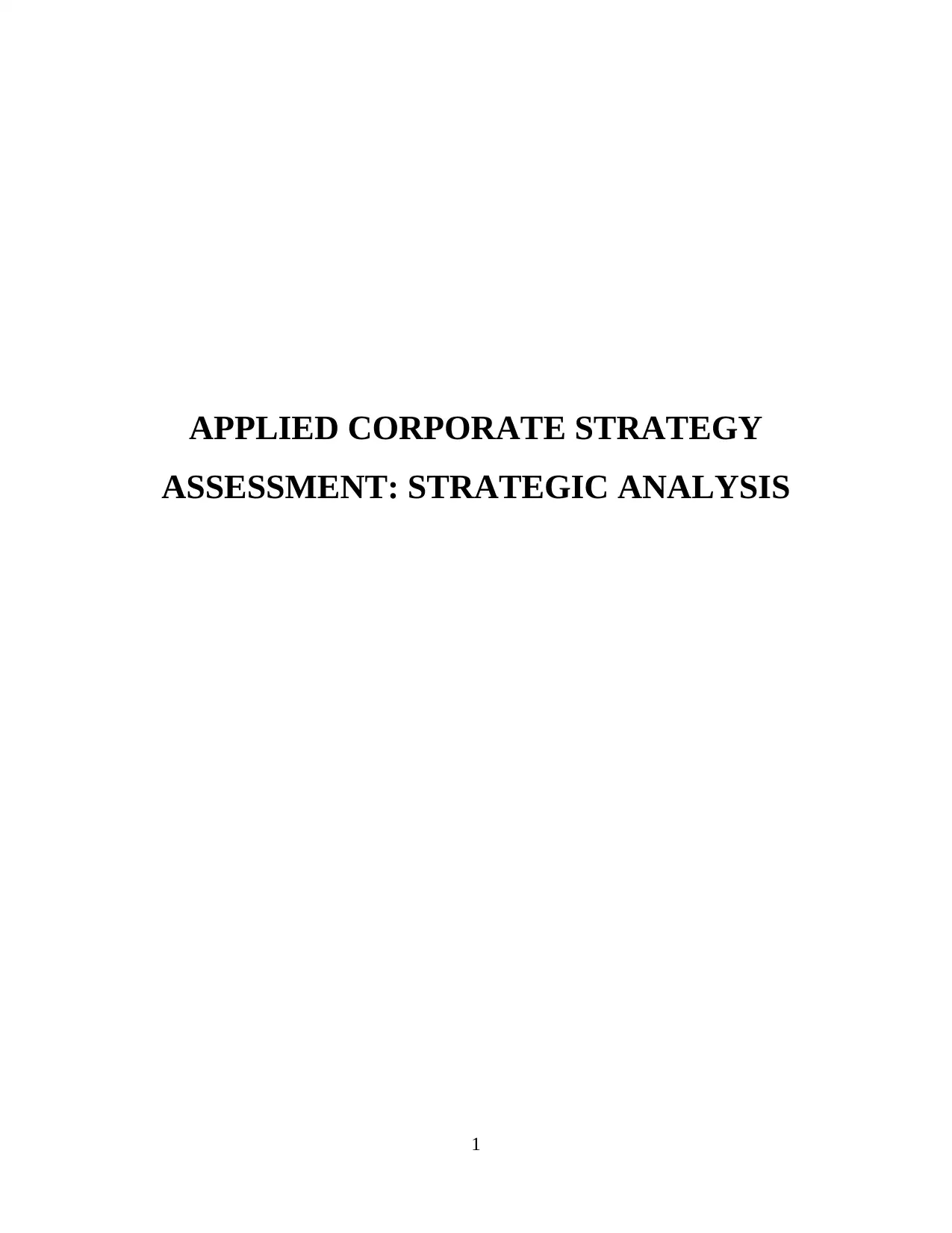
APPLIED CORPORATE STRATEGY
ASSESSMENT: STRATEGIC ANALYSIS
1
ASSESSMENT: STRATEGIC ANALYSIS
1
Paraphrase This Document
Need a fresh take? Get an instant paraphrase of this document with our AI Paraphraser
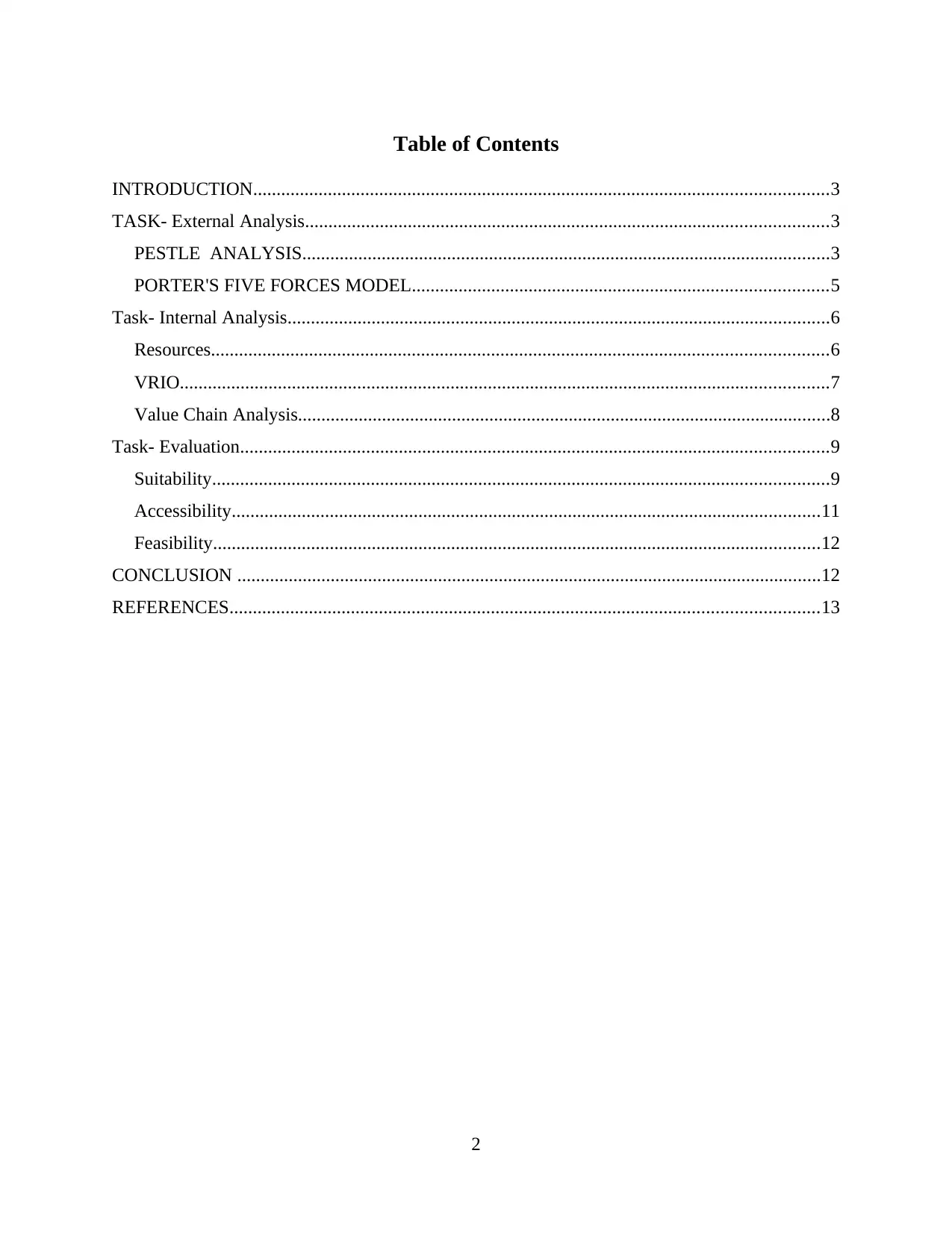
Table of Contents
INTRODUCTION...........................................................................................................................3
TASK- External Analysis................................................................................................................3
PESTLE ANALYSIS.................................................................................................................3
PORTER'S FIVE FORCES MODEL.........................................................................................5
Task- Internal Analysis....................................................................................................................6
Resources....................................................................................................................................6
VRIO...........................................................................................................................................7
Value Chain Analysis..................................................................................................................8
Task- Evaluation..............................................................................................................................9
Suitability....................................................................................................................................9
Accessibility..............................................................................................................................11
Feasibility..................................................................................................................................12
CONCLUSION .............................................................................................................................12
REFERENCES..............................................................................................................................13
2
INTRODUCTION...........................................................................................................................3
TASK- External Analysis................................................................................................................3
PESTLE ANALYSIS.................................................................................................................3
PORTER'S FIVE FORCES MODEL.........................................................................................5
Task- Internal Analysis....................................................................................................................6
Resources....................................................................................................................................6
VRIO...........................................................................................................................................7
Value Chain Analysis..................................................................................................................8
Task- Evaluation..............................................................................................................................9
Suitability....................................................................................................................................9
Accessibility..............................................................................................................................11
Feasibility..................................................................................................................................12
CONCLUSION .............................................................................................................................12
REFERENCES..............................................................................................................................13
2
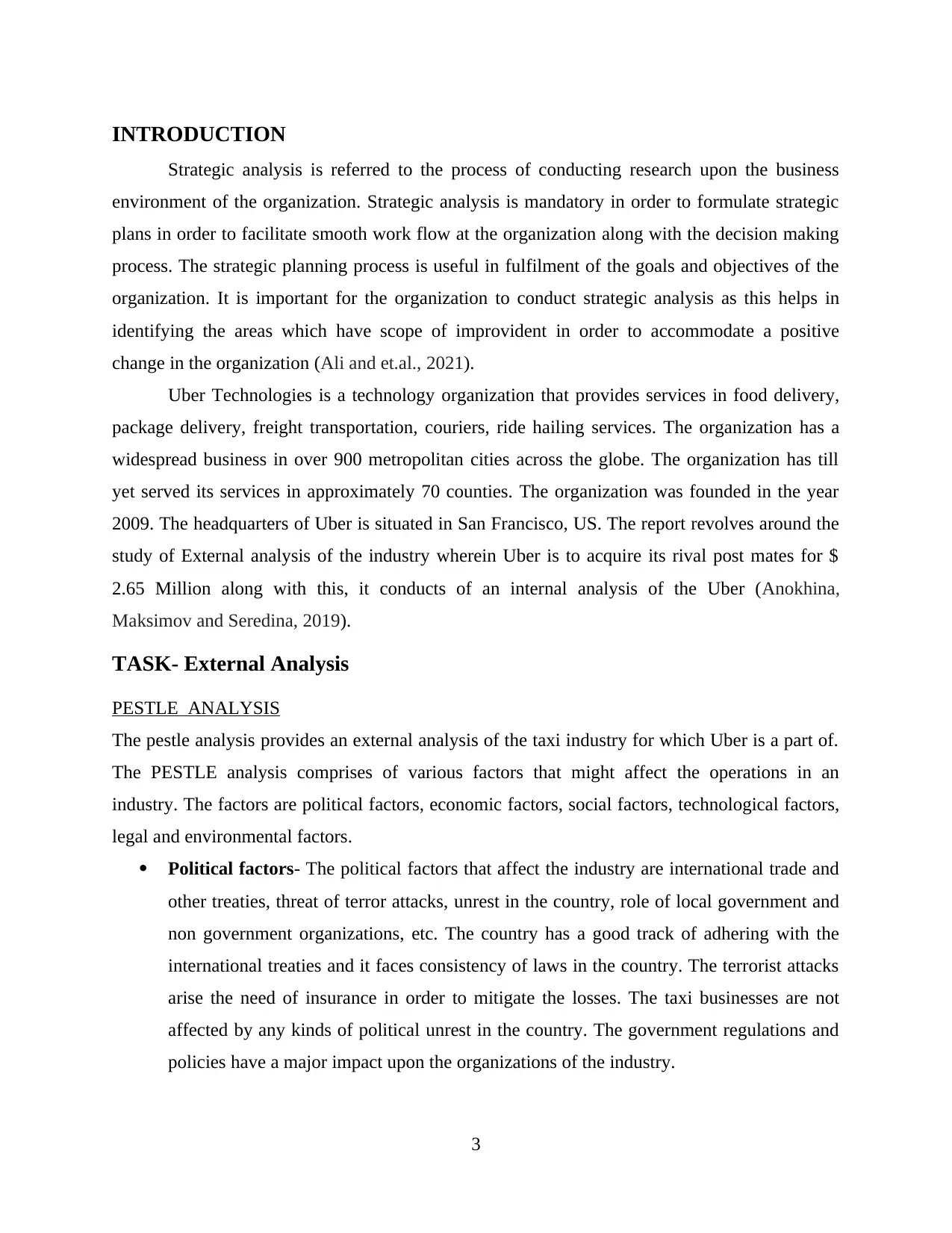
INTRODUCTION
Strategic analysis is referred to the process of conducting research upon the business
environment of the organization. Strategic analysis is mandatory in order to formulate strategic
plans in order to facilitate smooth work flow at the organization along with the decision making
process. The strategic planning process is useful in fulfilment of the goals and objectives of the
organization. It is important for the organization to conduct strategic analysis as this helps in
identifying the areas which have scope of improvident in order to accommodate a positive
change in the organization (Ali and et.al., 2021).
Uber Technologies is a technology organization that provides services in food delivery,
package delivery, freight transportation, couriers, ride hailing services. The organization has a
widespread business in over 900 metropolitan cities across the globe. The organization has till
yet served its services in approximately 70 counties. The organization was founded in the year
2009. The headquarters of Uber is situated in San Francisco, US. The report revolves around the
study of External analysis of the industry wherein Uber is to acquire its rival post mates for $
2.65 Million along with this, it conducts of an internal analysis of the Uber (Anokhina,
Maksimov and Seredina, 2019).
TASK- External Analysis
PESTLE ANALYSIS
The pestle analysis provides an external analysis of the taxi industry for which Uber is a part of.
The PESTLE analysis comprises of various factors that might affect the operations in an
industry. The factors are political factors, economic factors, social factors, technological factors,
legal and environmental factors.
Political factors- The political factors that affect the industry are international trade and
other treaties, threat of terror attacks, unrest in the country, role of local government and
non government organizations, etc. The country has a good track of adhering with the
international treaties and it faces consistency of laws in the country. The terrorist attacks
arise the need of insurance in order to mitigate the losses. The taxi businesses are not
affected by any kinds of political unrest in the country. The government regulations and
policies have a major impact upon the organizations of the industry.
3
Strategic analysis is referred to the process of conducting research upon the business
environment of the organization. Strategic analysis is mandatory in order to formulate strategic
plans in order to facilitate smooth work flow at the organization along with the decision making
process. The strategic planning process is useful in fulfilment of the goals and objectives of the
organization. It is important for the organization to conduct strategic analysis as this helps in
identifying the areas which have scope of improvident in order to accommodate a positive
change in the organization (Ali and et.al., 2021).
Uber Technologies is a technology organization that provides services in food delivery,
package delivery, freight transportation, couriers, ride hailing services. The organization has a
widespread business in over 900 metropolitan cities across the globe. The organization has till
yet served its services in approximately 70 counties. The organization was founded in the year
2009. The headquarters of Uber is situated in San Francisco, US. The report revolves around the
study of External analysis of the industry wherein Uber is to acquire its rival post mates for $
2.65 Million along with this, it conducts of an internal analysis of the Uber (Anokhina,
Maksimov and Seredina, 2019).
TASK- External Analysis
PESTLE ANALYSIS
The pestle analysis provides an external analysis of the taxi industry for which Uber is a part of.
The PESTLE analysis comprises of various factors that might affect the operations in an
industry. The factors are political factors, economic factors, social factors, technological factors,
legal and environmental factors.
Political factors- The political factors that affect the industry are international trade and
other treaties, threat of terror attacks, unrest in the country, role of local government and
non government organizations, etc. The country has a good track of adhering with the
international treaties and it faces consistency of laws in the country. The terrorist attacks
arise the need of insurance in order to mitigate the losses. The taxi businesses are not
affected by any kinds of political unrest in the country. The government regulations and
policies have a major impact upon the organizations of the industry.
3
⊘ This is a preview!⊘
Do you want full access?
Subscribe today to unlock all pages.

Trusted by 1+ million students worldwide
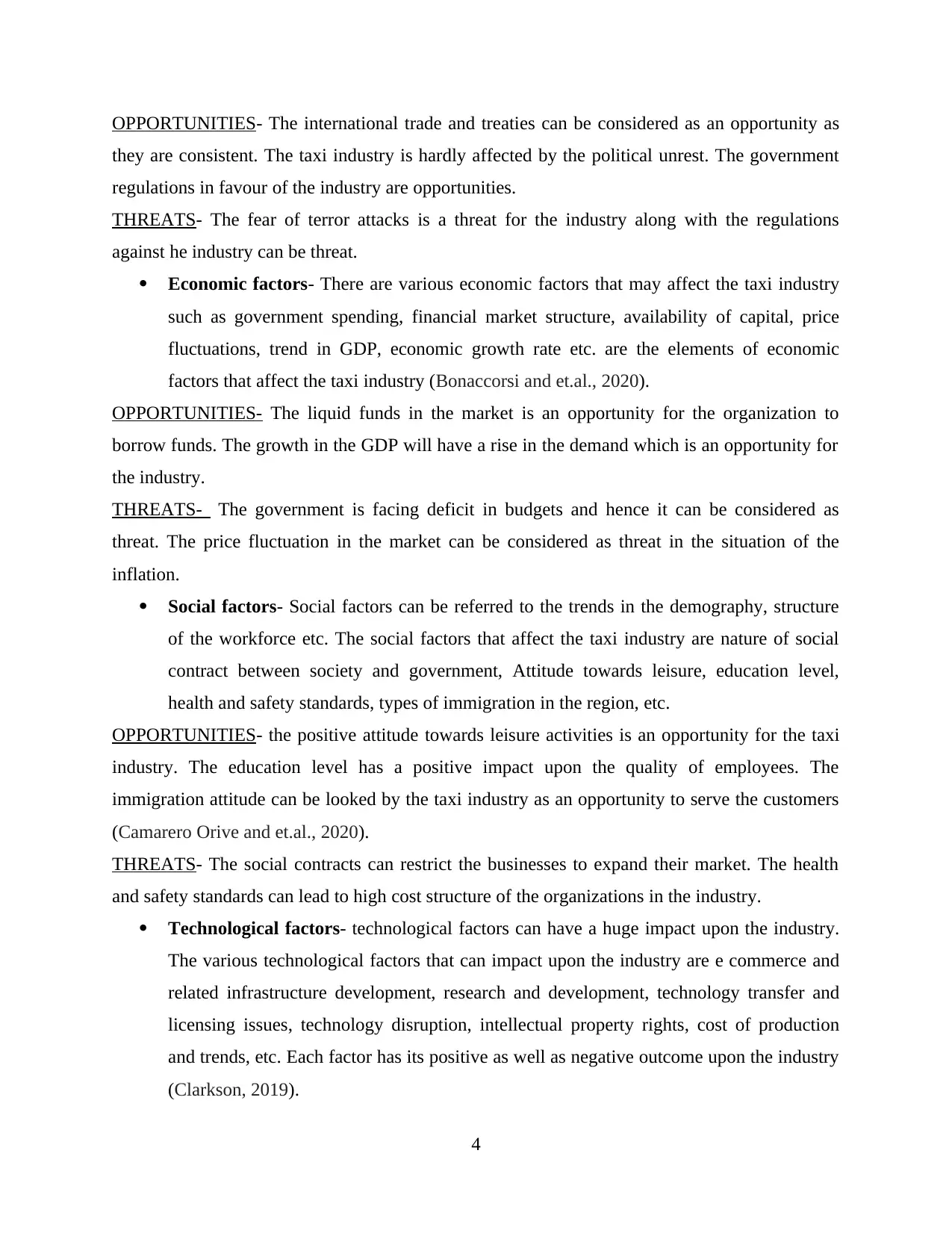
OPPORTUNITIES- The international trade and treaties can be considered as an opportunity as
they are consistent. The taxi industry is hardly affected by the political unrest. The government
regulations in favour of the industry are opportunities.
THREATS- The fear of terror attacks is a threat for the industry along with the regulations
against he industry can be threat.
Economic factors- There are various economic factors that may affect the taxi industry
such as government spending, financial market structure, availability of capital, price
fluctuations, trend in GDP, economic growth rate etc. are the elements of economic
factors that affect the taxi industry (Bonaccorsi and et.al., 2020).
OPPORTUNITIES- The liquid funds in the market is an opportunity for the organization to
borrow funds. The growth in the GDP will have a rise in the demand which is an opportunity for
the industry.
THREATS- The government is facing deficit in budgets and hence it can be considered as
threat. The price fluctuation in the market can be considered as threat in the situation of the
inflation.
Social factors- Social factors can be referred to the trends in the demography, structure
of the workforce etc. The social factors that affect the taxi industry are nature of social
contract between society and government, Attitude towards leisure, education level,
health and safety standards, types of immigration in the region, etc.
OPPORTUNITIES- the positive attitude towards leisure activities is an opportunity for the taxi
industry. The education level has a positive impact upon the quality of employees. The
immigration attitude can be looked by the taxi industry as an opportunity to serve the customers
(Camarero Orive and et.al., 2020).
THREATS- The social contracts can restrict the businesses to expand their market. The health
and safety standards can lead to high cost structure of the organizations in the industry.
Technological factors- technological factors can have a huge impact upon the industry.
The various technological factors that can impact upon the industry are e commerce and
related infrastructure development, research and development, technology transfer and
licensing issues, technology disruption, intellectual property rights, cost of production
and trends, etc. Each factor has its positive as well as negative outcome upon the industry
(Clarkson, 2019).
4
they are consistent. The taxi industry is hardly affected by the political unrest. The government
regulations in favour of the industry are opportunities.
THREATS- The fear of terror attacks is a threat for the industry along with the regulations
against he industry can be threat.
Economic factors- There are various economic factors that may affect the taxi industry
such as government spending, financial market structure, availability of capital, price
fluctuations, trend in GDP, economic growth rate etc. are the elements of economic
factors that affect the taxi industry (Bonaccorsi and et.al., 2020).
OPPORTUNITIES- The liquid funds in the market is an opportunity for the organization to
borrow funds. The growth in the GDP will have a rise in the demand which is an opportunity for
the industry.
THREATS- The government is facing deficit in budgets and hence it can be considered as
threat. The price fluctuation in the market can be considered as threat in the situation of the
inflation.
Social factors- Social factors can be referred to the trends in the demography, structure
of the workforce etc. The social factors that affect the taxi industry are nature of social
contract between society and government, Attitude towards leisure, education level,
health and safety standards, types of immigration in the region, etc.
OPPORTUNITIES- the positive attitude towards leisure activities is an opportunity for the taxi
industry. The education level has a positive impact upon the quality of employees. The
immigration attitude can be looked by the taxi industry as an opportunity to serve the customers
(Camarero Orive and et.al., 2020).
THREATS- The social contracts can restrict the businesses to expand their market. The health
and safety standards can lead to high cost structure of the organizations in the industry.
Technological factors- technological factors can have a huge impact upon the industry.
The various technological factors that can impact upon the industry are e commerce and
related infrastructure development, research and development, technology transfer and
licensing issues, technology disruption, intellectual property rights, cost of production
and trends, etc. Each factor has its positive as well as negative outcome upon the industry
(Clarkson, 2019).
4
Paraphrase This Document
Need a fresh take? Get an instant paraphrase of this document with our AI Paraphraser
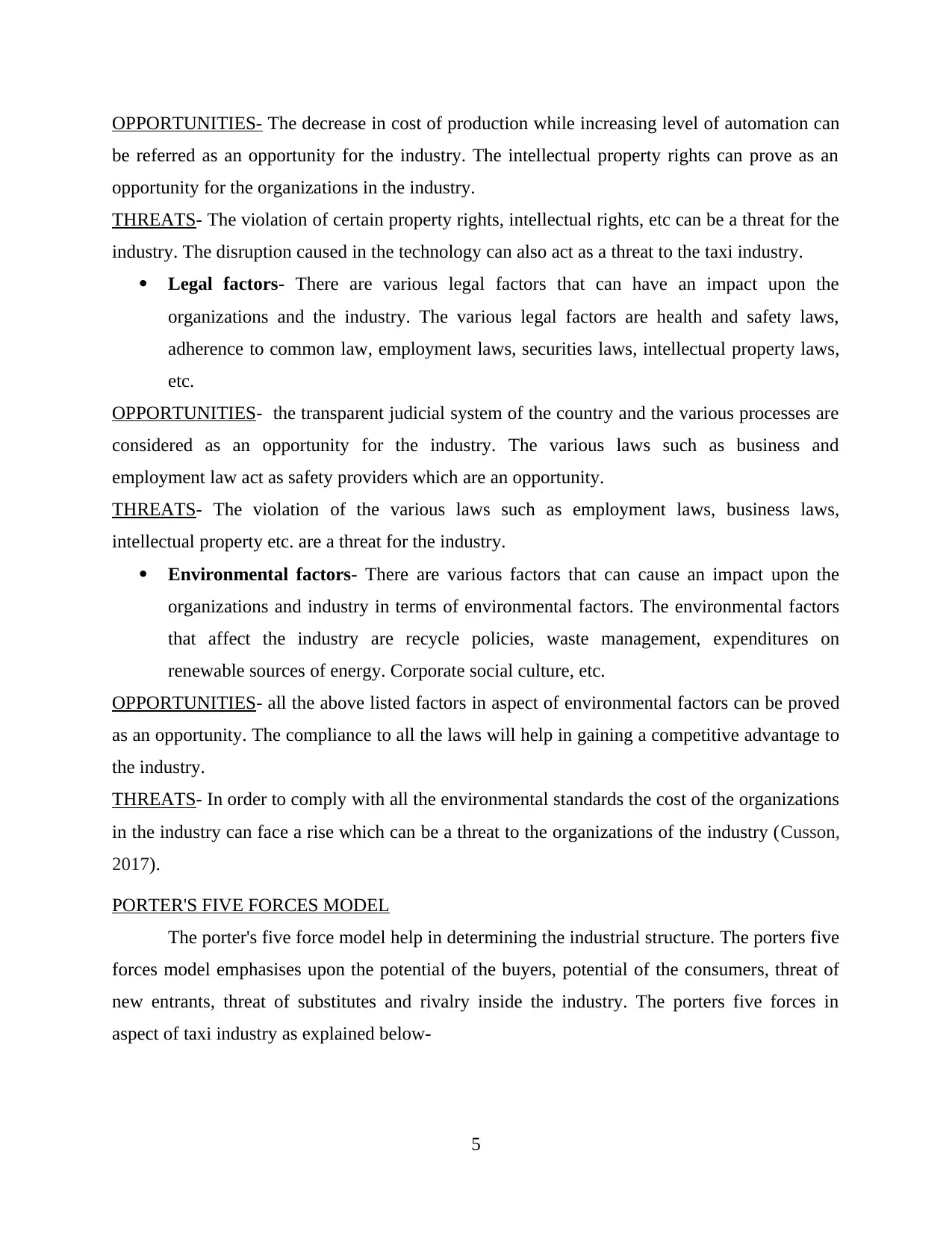
OPPORTUNITIES- The decrease in cost of production while increasing level of automation can
be referred as an opportunity for the industry. The intellectual property rights can prove as an
opportunity for the organizations in the industry.
THREATS- The violation of certain property rights, intellectual rights, etc can be a threat for the
industry. The disruption caused in the technology can also act as a threat to the taxi industry.
Legal factors- There are various legal factors that can have an impact upon the
organizations and the industry. The various legal factors are health and safety laws,
adherence to common law, employment laws, securities laws, intellectual property laws,
etc.
OPPORTUNITIES- the transparent judicial system of the country and the various processes are
considered as an opportunity for the industry. The various laws such as business and
employment law act as safety providers which are an opportunity.
THREATS- The violation of the various laws such as employment laws, business laws,
intellectual property etc. are a threat for the industry.
Environmental factors- There are various factors that can cause an impact upon the
organizations and industry in terms of environmental factors. The environmental factors
that affect the industry are recycle policies, waste management, expenditures on
renewable sources of energy. Corporate social culture, etc.
OPPORTUNITIES- all the above listed factors in aspect of environmental factors can be proved
as an opportunity. The compliance to all the laws will help in gaining a competitive advantage to
the industry.
THREATS- In order to comply with all the environmental standards the cost of the organizations
in the industry can face a rise which can be a threat to the organizations of the industry (Cusson,
2017).
PORTER'S FIVE FORCES MODEL
The porter's five force model help in determining the industrial structure. The porters five
forces model emphasises upon the potential of the buyers, potential of the consumers, threat of
new entrants, threat of substitutes and rivalry inside the industry. The porters five forces in
aspect of taxi industry as explained below-
5
be referred as an opportunity for the industry. The intellectual property rights can prove as an
opportunity for the organizations in the industry.
THREATS- The violation of certain property rights, intellectual rights, etc can be a threat for the
industry. The disruption caused in the technology can also act as a threat to the taxi industry.
Legal factors- There are various legal factors that can have an impact upon the
organizations and the industry. The various legal factors are health and safety laws,
adherence to common law, employment laws, securities laws, intellectual property laws,
etc.
OPPORTUNITIES- the transparent judicial system of the country and the various processes are
considered as an opportunity for the industry. The various laws such as business and
employment law act as safety providers which are an opportunity.
THREATS- The violation of the various laws such as employment laws, business laws,
intellectual property etc. are a threat for the industry.
Environmental factors- There are various factors that can cause an impact upon the
organizations and industry in terms of environmental factors. The environmental factors
that affect the industry are recycle policies, waste management, expenditures on
renewable sources of energy. Corporate social culture, etc.
OPPORTUNITIES- all the above listed factors in aspect of environmental factors can be proved
as an opportunity. The compliance to all the laws will help in gaining a competitive advantage to
the industry.
THREATS- In order to comply with all the environmental standards the cost of the organizations
in the industry can face a rise which can be a threat to the organizations of the industry (Cusson,
2017).
PORTER'S FIVE FORCES MODEL
The porter's five force model help in determining the industrial structure. The porters five
forces model emphasises upon the potential of the buyers, potential of the consumers, threat of
new entrants, threat of substitutes and rivalry inside the industry. The porters five forces in
aspect of taxi industry as explained below-
5
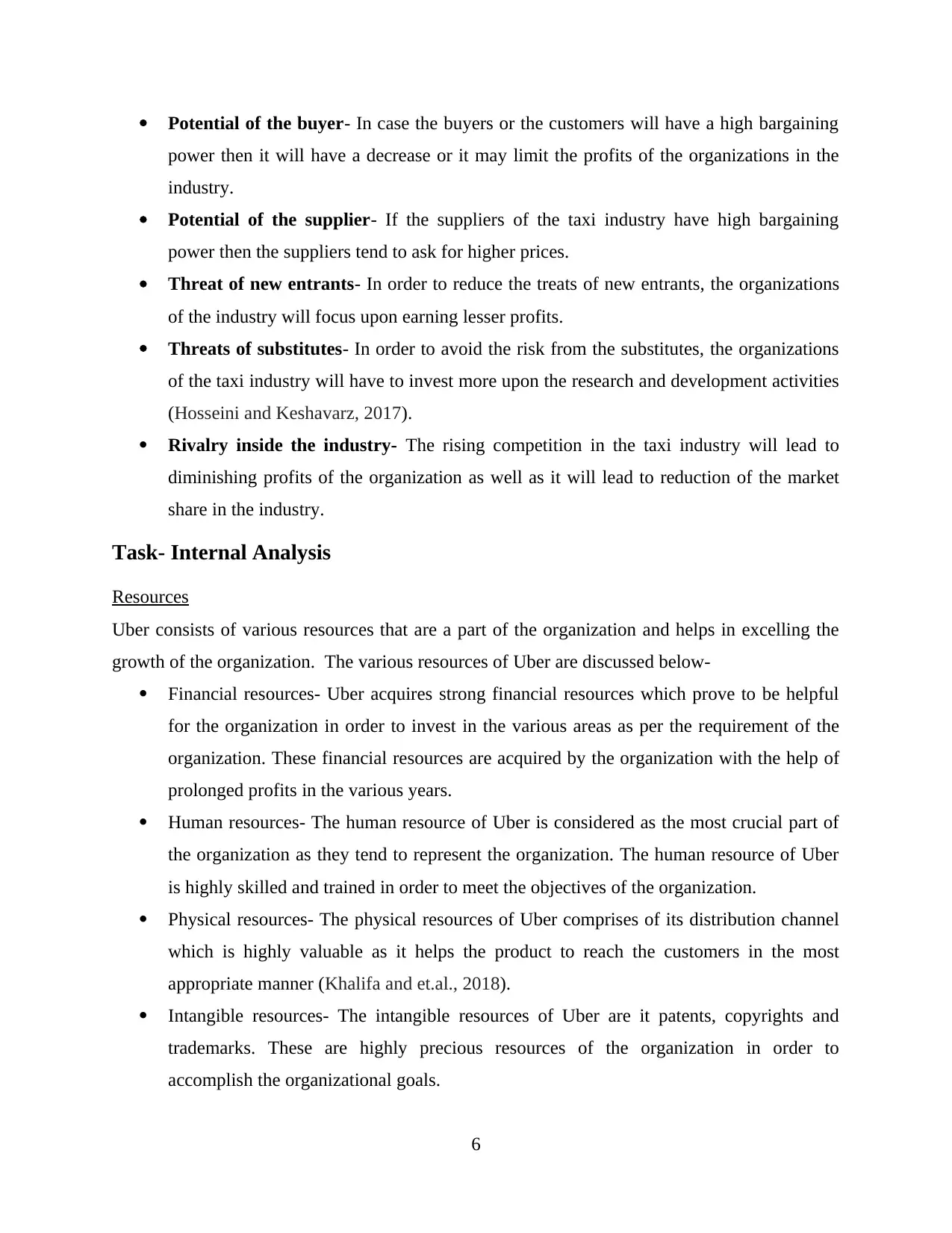
Potential of the buyer- In case the buyers or the customers will have a high bargaining
power then it will have a decrease or it may limit the profits of the organizations in the
industry.
Potential of the supplier- If the suppliers of the taxi industry have high bargaining
power then the suppliers tend to ask for higher prices.
Threat of new entrants- In order to reduce the treats of new entrants, the organizations
of the industry will focus upon earning lesser profits.
Threats of substitutes- In order to avoid the risk from the substitutes, the organizations
of the taxi industry will have to invest more upon the research and development activities
(Hosseini and Keshavarz, 2017).
Rivalry inside the industry- The rising competition in the taxi industry will lead to
diminishing profits of the organization as well as it will lead to reduction of the market
share in the industry.
Task- Internal Analysis
Resources
Uber consists of various resources that are a part of the organization and helps in excelling the
growth of the organization. The various resources of Uber are discussed below-
Financial resources- Uber acquires strong financial resources which prove to be helpful
for the organization in order to invest in the various areas as per the requirement of the
organization. These financial resources are acquired by the organization with the help of
prolonged profits in the various years.
Human resources- The human resource of Uber is considered as the most crucial part of
the organization as they tend to represent the organization. The human resource of Uber
is highly skilled and trained in order to meet the objectives of the organization.
Physical resources- The physical resources of Uber comprises of its distribution channel
which is highly valuable as it helps the product to reach the customers in the most
appropriate manner (Khalifa and et.al., 2018).
Intangible resources- The intangible resources of Uber are it patents, copyrights and
trademarks. These are highly precious resources of the organization in order to
accomplish the organizational goals.
6
power then it will have a decrease or it may limit the profits of the organizations in the
industry.
Potential of the supplier- If the suppliers of the taxi industry have high bargaining
power then the suppliers tend to ask for higher prices.
Threat of new entrants- In order to reduce the treats of new entrants, the organizations
of the industry will focus upon earning lesser profits.
Threats of substitutes- In order to avoid the risk from the substitutes, the organizations
of the taxi industry will have to invest more upon the research and development activities
(Hosseini and Keshavarz, 2017).
Rivalry inside the industry- The rising competition in the taxi industry will lead to
diminishing profits of the organization as well as it will lead to reduction of the market
share in the industry.
Task- Internal Analysis
Resources
Uber consists of various resources that are a part of the organization and helps in excelling the
growth of the organization. The various resources of Uber are discussed below-
Financial resources- Uber acquires strong financial resources which prove to be helpful
for the organization in order to invest in the various areas as per the requirement of the
organization. These financial resources are acquired by the organization with the help of
prolonged profits in the various years.
Human resources- The human resource of Uber is considered as the most crucial part of
the organization as they tend to represent the organization. The human resource of Uber
is highly skilled and trained in order to meet the objectives of the organization.
Physical resources- The physical resources of Uber comprises of its distribution channel
which is highly valuable as it helps the product to reach the customers in the most
appropriate manner (Khalifa and et.al., 2018).
Intangible resources- The intangible resources of Uber are it patents, copyrights and
trademarks. These are highly precious resources of the organization in order to
accomplish the organizational goals.
6
⊘ This is a preview!⊘
Do you want full access?
Subscribe today to unlock all pages.

Trusted by 1+ million students worldwide
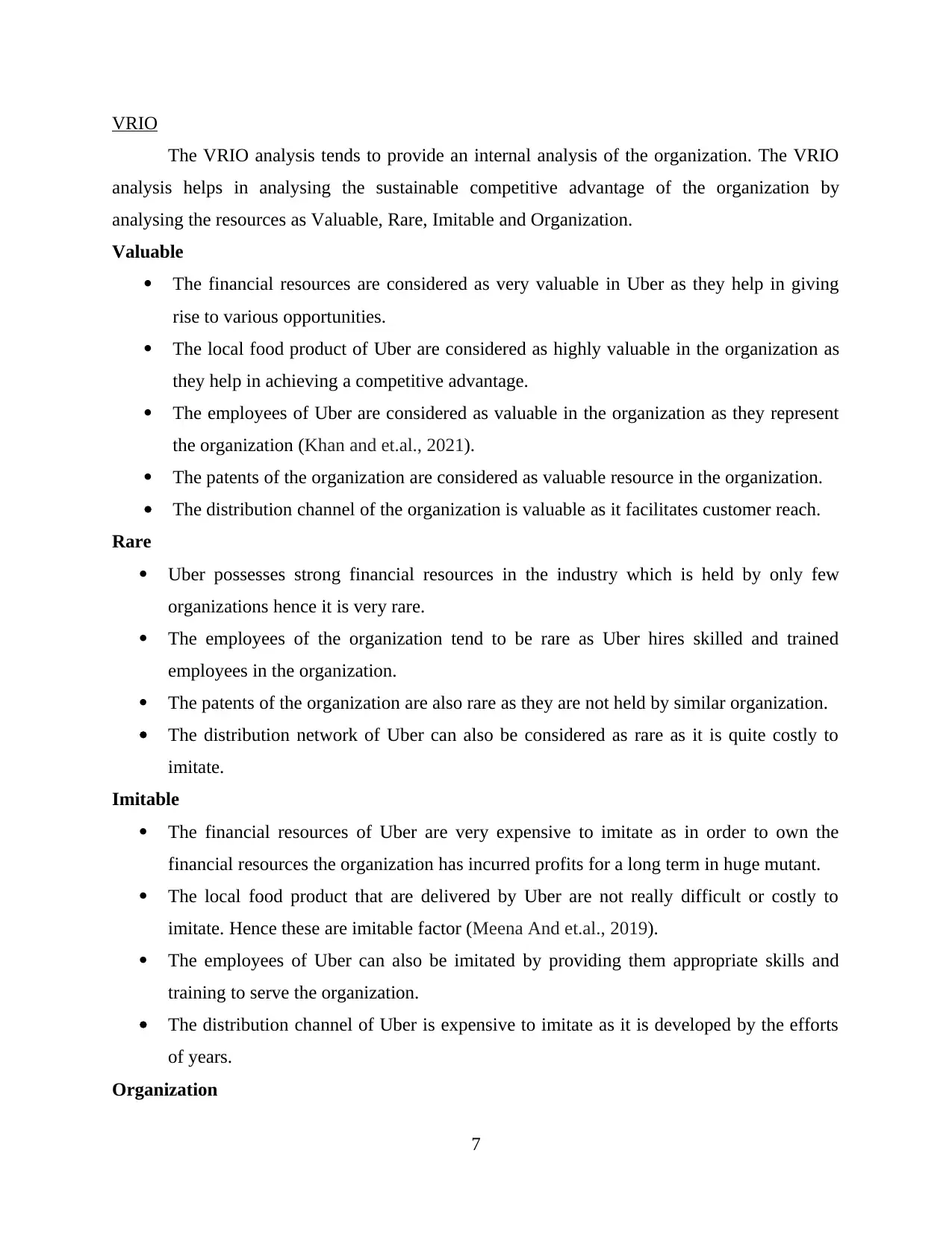
VRIO
The VRIO analysis tends to provide an internal analysis of the organization. The VRIO
analysis helps in analysing the sustainable competitive advantage of the organization by
analysing the resources as Valuable, Rare, Imitable and Organization.
Valuable
The financial resources are considered as very valuable in Uber as they help in giving
rise to various opportunities.
The local food product of Uber are considered as highly valuable in the organization as
they help in achieving a competitive advantage.
The employees of Uber are considered as valuable in the organization as they represent
the organization (Khan and et.al., 2021).
The patents of the organization are considered as valuable resource in the organization.
The distribution channel of the organization is valuable as it facilitates customer reach.
Rare
Uber possesses strong financial resources in the industry which is held by only few
organizations hence it is very rare.
The employees of the organization tend to be rare as Uber hires skilled and trained
employees in the organization.
The patents of the organization are also rare as they are not held by similar organization.
The distribution network of Uber can also be considered as rare as it is quite costly to
imitate.
Imitable
The financial resources of Uber are very expensive to imitate as in order to own the
financial resources the organization has incurred profits for a long term in huge mutant.
The local food product that are delivered by Uber are not really difficult or costly to
imitate. Hence these are imitable factor (Meena And et.al., 2019).
The employees of Uber can also be imitated by providing them appropriate skills and
training to serve the organization.
The distribution channel of Uber is expensive to imitate as it is developed by the efforts
of years.
Organization
7
The VRIO analysis tends to provide an internal analysis of the organization. The VRIO
analysis helps in analysing the sustainable competitive advantage of the organization by
analysing the resources as Valuable, Rare, Imitable and Organization.
Valuable
The financial resources are considered as very valuable in Uber as they help in giving
rise to various opportunities.
The local food product of Uber are considered as highly valuable in the organization as
they help in achieving a competitive advantage.
The employees of Uber are considered as valuable in the organization as they represent
the organization (Khan and et.al., 2021).
The patents of the organization are considered as valuable resource in the organization.
The distribution channel of the organization is valuable as it facilitates customer reach.
Rare
Uber possesses strong financial resources in the industry which is held by only few
organizations hence it is very rare.
The employees of the organization tend to be rare as Uber hires skilled and trained
employees in the organization.
The patents of the organization are also rare as they are not held by similar organization.
The distribution network of Uber can also be considered as rare as it is quite costly to
imitate.
Imitable
The financial resources of Uber are very expensive to imitate as in order to own the
financial resources the organization has incurred profits for a long term in huge mutant.
The local food product that are delivered by Uber are not really difficult or costly to
imitate. Hence these are imitable factor (Meena And et.al., 2019).
The employees of Uber can also be imitated by providing them appropriate skills and
training to serve the organization.
The distribution channel of Uber is expensive to imitate as it is developed by the efforts
of years.
Organization
7
Paraphrase This Document
Need a fresh take? Get an instant paraphrase of this document with our AI Paraphraser
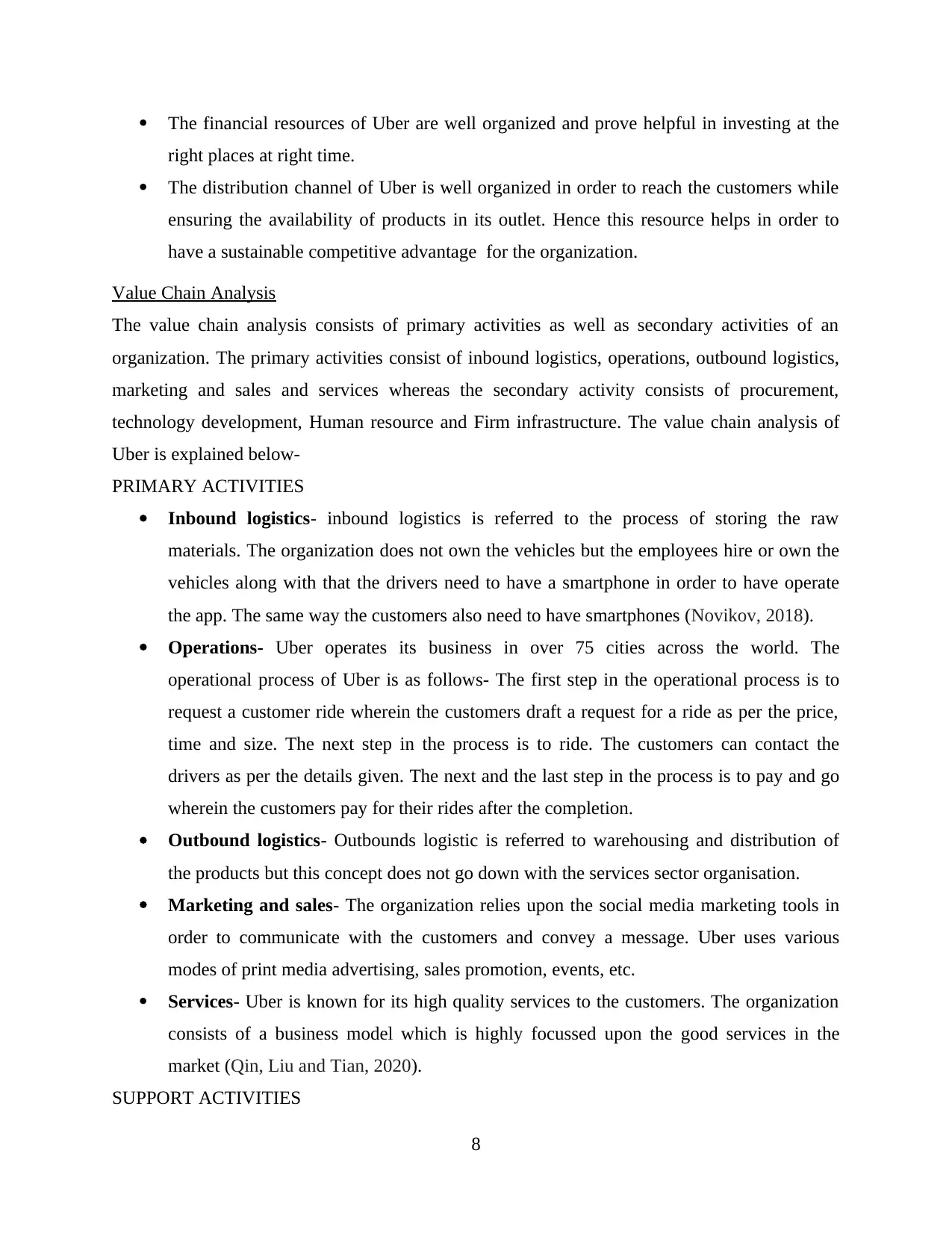
The financial resources of Uber are well organized and prove helpful in investing at the
right places at right time.
The distribution channel of Uber is well organized in order to reach the customers while
ensuring the availability of products in its outlet. Hence this resource helps in order to
have a sustainable competitive advantage for the organization.
Value Chain Analysis
The value chain analysis consists of primary activities as well as secondary activities of an
organization. The primary activities consist of inbound logistics, operations, outbound logistics,
marketing and sales and services whereas the secondary activity consists of procurement,
technology development, Human resource and Firm infrastructure. The value chain analysis of
Uber is explained below-
PRIMARY ACTIVITIES
Inbound logistics- inbound logistics is referred to the process of storing the raw
materials. The organization does not own the vehicles but the employees hire or own the
vehicles along with that the drivers need to have a smartphone in order to have operate
the app. The same way the customers also need to have smartphones (Novikov, 2018).
Operations- Uber operates its business in over 75 cities across the world. The
operational process of Uber is as follows- The first step in the operational process is to
request a customer ride wherein the customers draft a request for a ride as per the price,
time and size. The next step in the process is to ride. The customers can contact the
drivers as per the details given. The next and the last step in the process is to pay and go
wherein the customers pay for their rides after the completion.
Outbound logistics- Outbounds logistic is referred to warehousing and distribution of
the products but this concept does not go down with the services sector organisation.
Marketing and sales- The organization relies upon the social media marketing tools in
order to communicate with the customers and convey a message. Uber uses various
modes of print media advertising, sales promotion, events, etc.
Services- Uber is known for its high quality services to the customers. The organization
consists of a business model which is highly focussed upon the good services in the
market (Qin, Liu and Tian, 2020).
SUPPORT ACTIVITIES
8
right places at right time.
The distribution channel of Uber is well organized in order to reach the customers while
ensuring the availability of products in its outlet. Hence this resource helps in order to
have a sustainable competitive advantage for the organization.
Value Chain Analysis
The value chain analysis consists of primary activities as well as secondary activities of an
organization. The primary activities consist of inbound logistics, operations, outbound logistics,
marketing and sales and services whereas the secondary activity consists of procurement,
technology development, Human resource and Firm infrastructure. The value chain analysis of
Uber is explained below-
PRIMARY ACTIVITIES
Inbound logistics- inbound logistics is referred to the process of storing the raw
materials. The organization does not own the vehicles but the employees hire or own the
vehicles along with that the drivers need to have a smartphone in order to have operate
the app. The same way the customers also need to have smartphones (Novikov, 2018).
Operations- Uber operates its business in over 75 cities across the world. The
operational process of Uber is as follows- The first step in the operational process is to
request a customer ride wherein the customers draft a request for a ride as per the price,
time and size. The next step in the process is to ride. The customers can contact the
drivers as per the details given. The next and the last step in the process is to pay and go
wherein the customers pay for their rides after the completion.
Outbound logistics- Outbounds logistic is referred to warehousing and distribution of
the products but this concept does not go down with the services sector organisation.
Marketing and sales- The organization relies upon the social media marketing tools in
order to communicate with the customers and convey a message. Uber uses various
modes of print media advertising, sales promotion, events, etc.
Services- Uber is known for its high quality services to the customers. The organization
consists of a business model which is highly focussed upon the good services in the
market (Qin, Liu and Tian, 2020).
SUPPORT ACTIVITIES
8
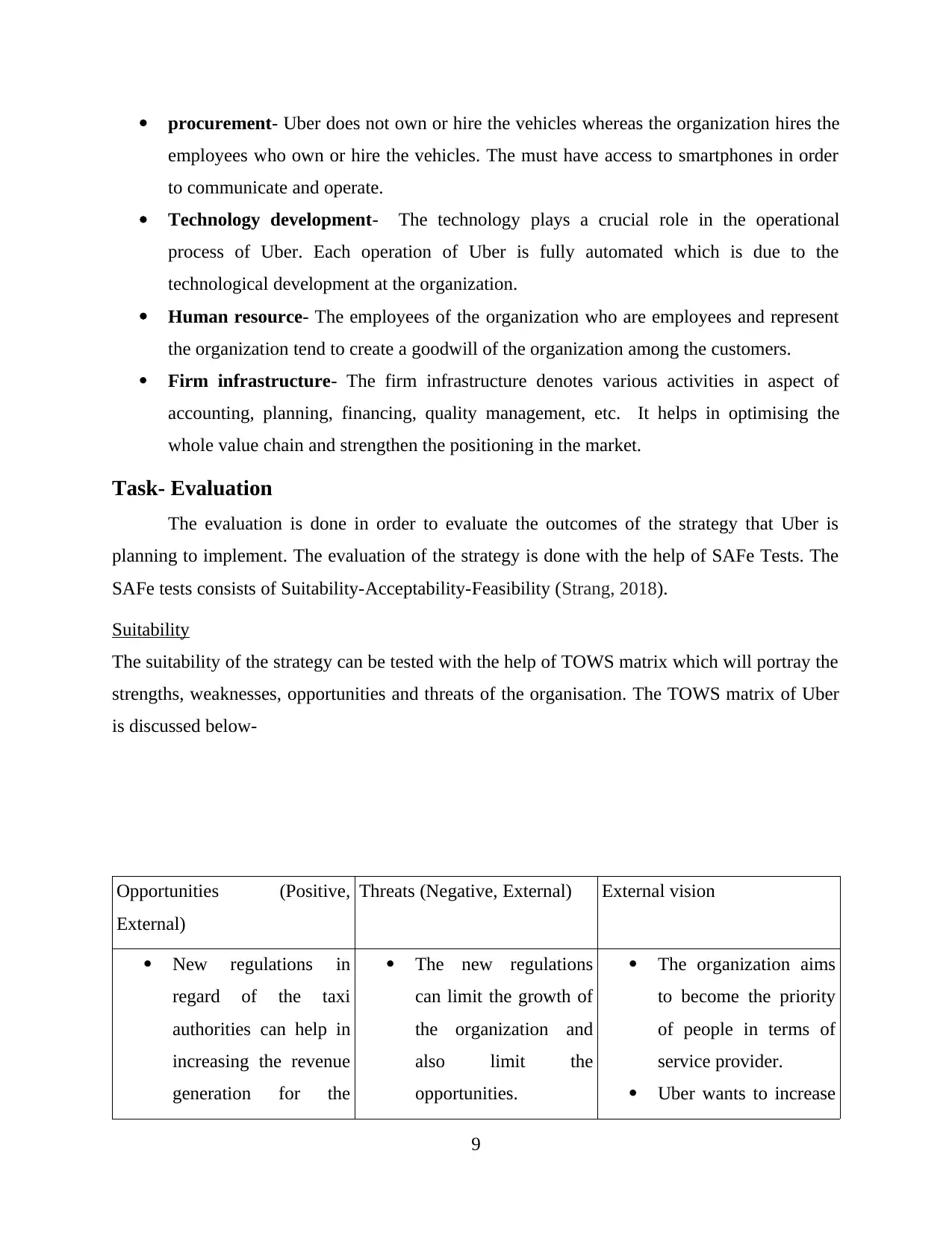
procurement- Uber does not own or hire the vehicles whereas the organization hires the
employees who own or hire the vehicles. The must have access to smartphones in order
to communicate and operate.
Technology development- The technology plays a crucial role in the operational
process of Uber. Each operation of Uber is fully automated which is due to the
technological development at the organization.
Human resource- The employees of the organization who are employees and represent
the organization tend to create a goodwill of the organization among the customers.
Firm infrastructure- The firm infrastructure denotes various activities in aspect of
accounting, planning, financing, quality management, etc. It helps in optimising the
whole value chain and strengthen the positioning in the market.
Task- Evaluation
The evaluation is done in order to evaluate the outcomes of the strategy that Uber is
planning to implement. The evaluation of the strategy is done with the help of SAFe Tests. The
SAFe tests consists of Suitability-Acceptability-Feasibility (Strang, 2018).
Suitability
The suitability of the strategy can be tested with the help of TOWS matrix which will portray the
strengths, weaknesses, opportunities and threats of the organisation. The TOWS matrix of Uber
is discussed below-
Opportunities (Positive,
External)
Threats (Negative, External) External vision
New regulations in
regard of the taxi
authorities can help in
increasing the revenue
generation for the
The new regulations
can limit the growth of
the organization and
also limit the
opportunities.
The organization aims
to become the priority
of people in terms of
service provider.
Uber wants to increase
9
employees who own or hire the vehicles. The must have access to smartphones in order
to communicate and operate.
Technology development- The technology plays a crucial role in the operational
process of Uber. Each operation of Uber is fully automated which is due to the
technological development at the organization.
Human resource- The employees of the organization who are employees and represent
the organization tend to create a goodwill of the organization among the customers.
Firm infrastructure- The firm infrastructure denotes various activities in aspect of
accounting, planning, financing, quality management, etc. It helps in optimising the
whole value chain and strengthen the positioning in the market.
Task- Evaluation
The evaluation is done in order to evaluate the outcomes of the strategy that Uber is
planning to implement. The evaluation of the strategy is done with the help of SAFe Tests. The
SAFe tests consists of Suitability-Acceptability-Feasibility (Strang, 2018).
Suitability
The suitability of the strategy can be tested with the help of TOWS matrix which will portray the
strengths, weaknesses, opportunities and threats of the organisation. The TOWS matrix of Uber
is discussed below-
Opportunities (Positive,
External)
Threats (Negative, External) External vision
New regulations in
regard of the taxi
authorities can help in
increasing the revenue
generation for the
The new regulations
can limit the growth of
the organization and
also limit the
opportunities.
The organization aims
to become the priority
of people in terms of
service provider.
Uber wants to increase
9
⊘ This is a preview!⊘
Do you want full access?
Subscribe today to unlock all pages.

Trusted by 1+ million students worldwide
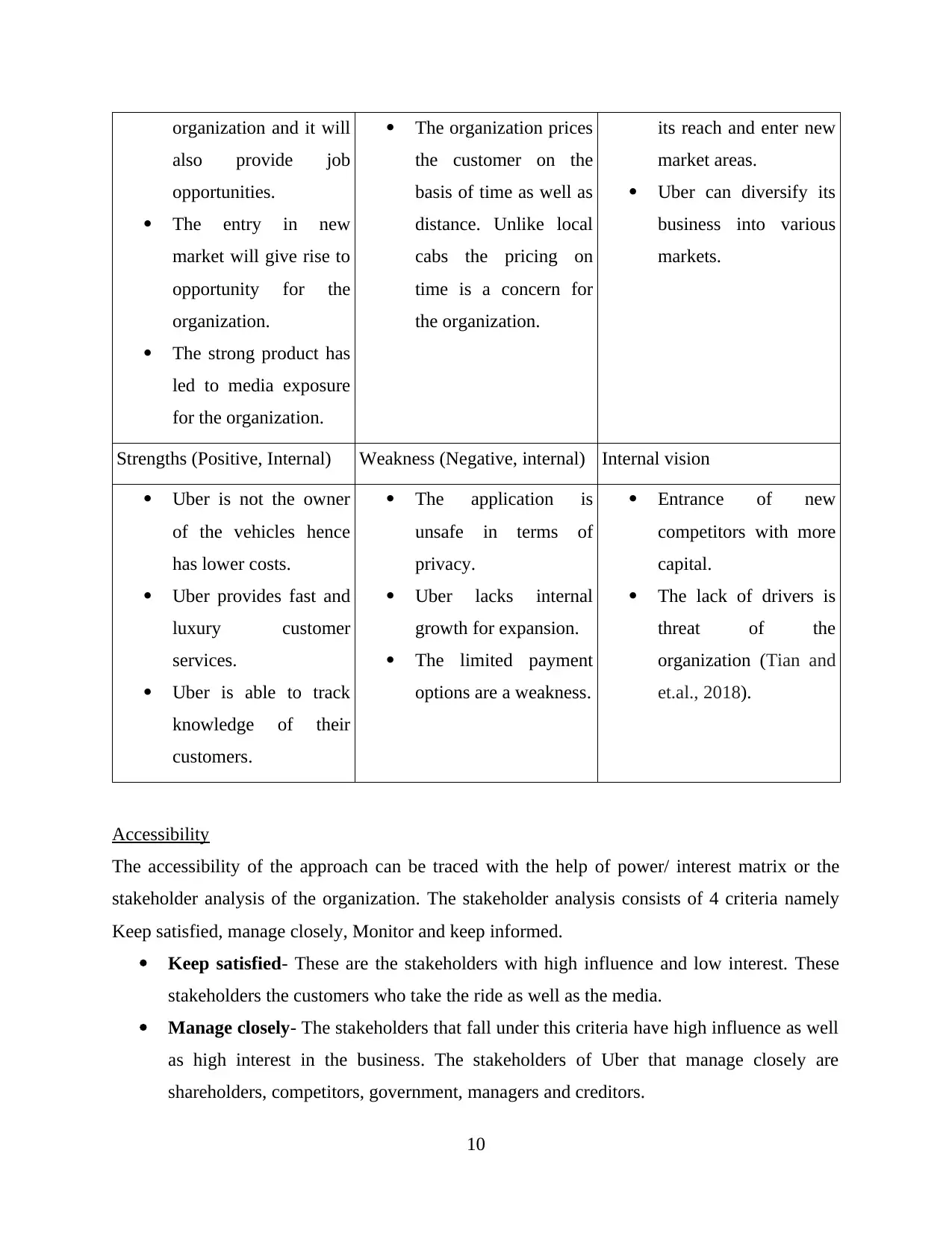
organization and it will
also provide job
opportunities.
The entry in new
market will give rise to
opportunity for the
organization.
The strong product has
led to media exposure
for the organization.
The organization prices
the customer on the
basis of time as well as
distance. Unlike local
cabs the pricing on
time is a concern for
the organization.
its reach and enter new
market areas.
Uber can diversify its
business into various
markets.
Strengths (Positive, Internal) Weakness (Negative, internal) Internal vision
Uber is not the owner
of the vehicles hence
has lower costs.
Uber provides fast and
luxury customer
services.
Uber is able to track
knowledge of their
customers.
The application is
unsafe in terms of
privacy.
Uber lacks internal
growth for expansion.
The limited payment
options are a weakness.
Entrance of new
competitors with more
capital.
The lack of drivers is
threat of the
organization (Tian and
et.al., 2018).
Accessibility
The accessibility of the approach can be traced with the help of power/ interest matrix or the
stakeholder analysis of the organization. The stakeholder analysis consists of 4 criteria namely
Keep satisfied, manage closely, Monitor and keep informed.
Keep satisfied- These are the stakeholders with high influence and low interest. These
stakeholders the customers who take the ride as well as the media.
Manage closely- The stakeholders that fall under this criteria have high influence as well
as high interest in the business. The stakeholders of Uber that manage closely are
shareholders, competitors, government, managers and creditors.
10
also provide job
opportunities.
The entry in new
market will give rise to
opportunity for the
organization.
The strong product has
led to media exposure
for the organization.
The organization prices
the customer on the
basis of time as well as
distance. Unlike local
cabs the pricing on
time is a concern for
the organization.
its reach and enter new
market areas.
Uber can diversify its
business into various
markets.
Strengths (Positive, Internal) Weakness (Negative, internal) Internal vision
Uber is not the owner
of the vehicles hence
has lower costs.
Uber provides fast and
luxury customer
services.
Uber is able to track
knowledge of their
customers.
The application is
unsafe in terms of
privacy.
Uber lacks internal
growth for expansion.
The limited payment
options are a weakness.
Entrance of new
competitors with more
capital.
The lack of drivers is
threat of the
organization (Tian and
et.al., 2018).
Accessibility
The accessibility of the approach can be traced with the help of power/ interest matrix or the
stakeholder analysis of the organization. The stakeholder analysis consists of 4 criteria namely
Keep satisfied, manage closely, Monitor and keep informed.
Keep satisfied- These are the stakeholders with high influence and low interest. These
stakeholders the customers who take the ride as well as the media.
Manage closely- The stakeholders that fall under this criteria have high influence as well
as high interest in the business. The stakeholders of Uber that manage closely are
shareholders, competitors, government, managers and creditors.
10
Paraphrase This Document
Need a fresh take? Get an instant paraphrase of this document with our AI Paraphraser
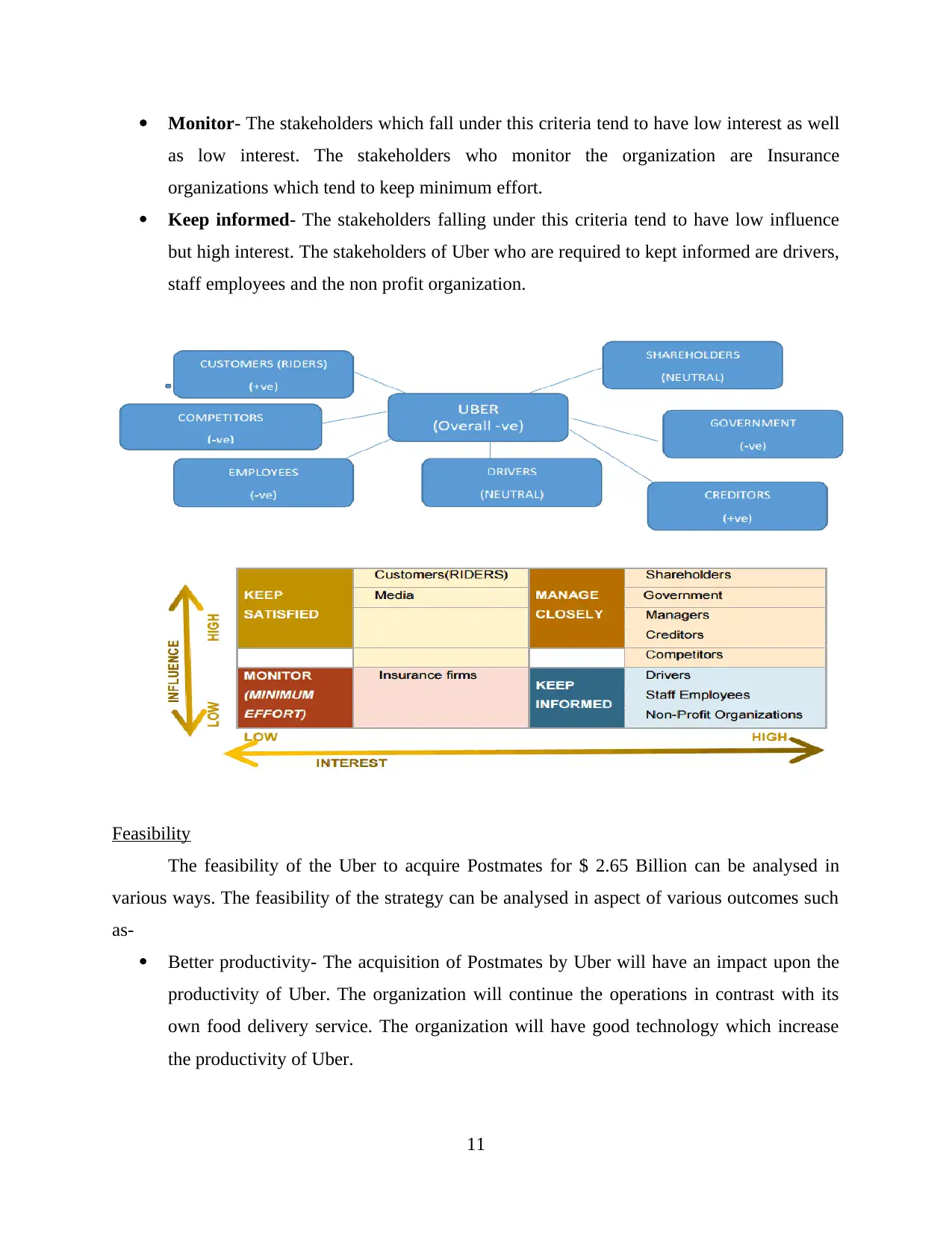
Monitor- The stakeholders which fall under this criteria tend to have low interest as well
as low interest. The stakeholders who monitor the organization are Insurance
organizations which tend to keep minimum effort.
Keep informed- The stakeholders falling under this criteria tend to have low influence
but high interest. The stakeholders of Uber who are required to kept informed are drivers,
staff employees and the non profit organization.
Feasibility
The feasibility of the Uber to acquire Postmates for $ 2.65 Billion can be analysed in
various ways. The feasibility of the strategy can be analysed in aspect of various outcomes such
as-
Better productivity- The acquisition of Postmates by Uber will have an impact upon the
productivity of Uber. The organization will continue the operations in contrast with its
own food delivery service. The organization will have good technology which increase
the productivity of Uber.
11
as low interest. The stakeholders who monitor the organization are Insurance
organizations which tend to keep minimum effort.
Keep informed- The stakeholders falling under this criteria tend to have low influence
but high interest. The stakeholders of Uber who are required to kept informed are drivers,
staff employees and the non profit organization.
Feasibility
The feasibility of the Uber to acquire Postmates for $ 2.65 Billion can be analysed in
various ways. The feasibility of the strategy can be analysed in aspect of various outcomes such
as-
Better productivity- The acquisition of Postmates by Uber will have an impact upon the
productivity of Uber. The organization will continue the operations in contrast with its
own food delivery service. The organization will have good technology which increase
the productivity of Uber.
11
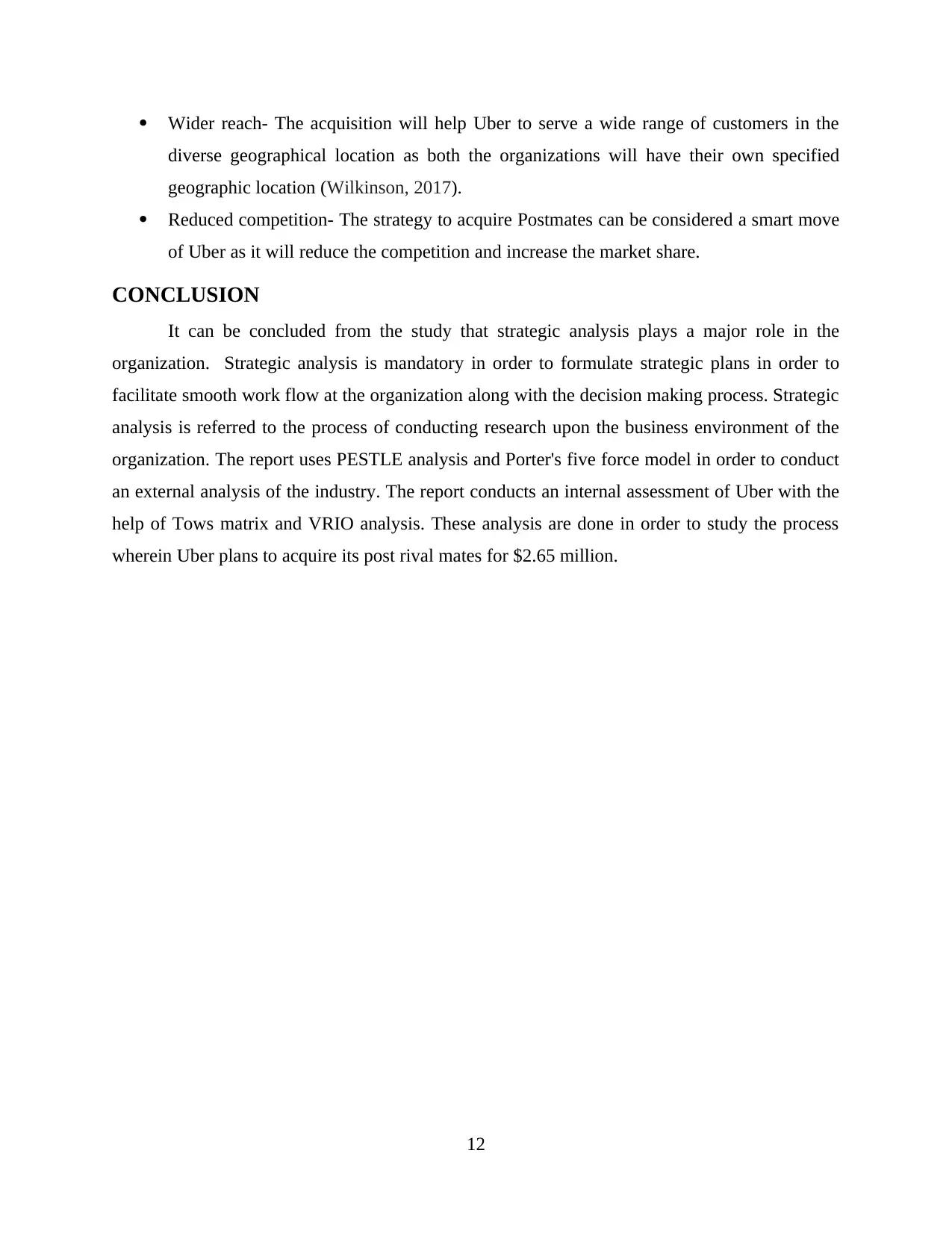
Wider reach- The acquisition will help Uber to serve a wide range of customers in the
diverse geographical location as both the organizations will have their own specified
geographic location (Wilkinson, 2017).
Reduced competition- The strategy to acquire Postmates can be considered a smart move
of Uber as it will reduce the competition and increase the market share.
CONCLUSION
It can be concluded from the study that strategic analysis plays a major role in the
organization. Strategic analysis is mandatory in order to formulate strategic plans in order to
facilitate smooth work flow at the organization along with the decision making process. Strategic
analysis is referred to the process of conducting research upon the business environment of the
organization. The report uses PESTLE analysis and Porter's five force model in order to conduct
an external analysis of the industry. The report conducts an internal assessment of Uber with the
help of Tows matrix and VRIO analysis. These analysis are done in order to study the process
wherein Uber plans to acquire its post rival mates for $2.65 million.
12
diverse geographical location as both the organizations will have their own specified
geographic location (Wilkinson, 2017).
Reduced competition- The strategy to acquire Postmates can be considered a smart move
of Uber as it will reduce the competition and increase the market share.
CONCLUSION
It can be concluded from the study that strategic analysis plays a major role in the
organization. Strategic analysis is mandatory in order to formulate strategic plans in order to
facilitate smooth work flow at the organization along with the decision making process. Strategic
analysis is referred to the process of conducting research upon the business environment of the
organization. The report uses PESTLE analysis and Porter's five force model in order to conduct
an external analysis of the industry. The report conducts an internal assessment of Uber with the
help of Tows matrix and VRIO analysis. These analysis are done in order to study the process
wherein Uber plans to acquire its post rival mates for $2.65 million.
12
⊘ This is a preview!⊘
Do you want full access?
Subscribe today to unlock all pages.

Trusted by 1+ million students worldwide
1 out of 13
Related Documents
Your All-in-One AI-Powered Toolkit for Academic Success.
+13062052269
info@desklib.com
Available 24*7 on WhatsApp / Email
![[object Object]](/_next/static/media/star-bottom.7253800d.svg)
Unlock your academic potential
Copyright © 2020–2025 A2Z Services. All Rights Reserved. Developed and managed by ZUCOL.





